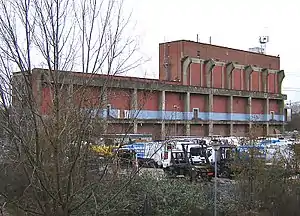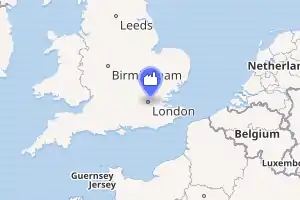Hackney Power Station
Hackney Power Station (also known as Millfields Power Station) was a coal-fired power station situated at Lea Bridge on the River Lee Navigation in London.
| Hackney Power Station | |
|---|---|
 | |

| |
| Country | England |
| Location | Hackney, London |
| Coordinates | 51.55870°N 0.04010°W |
| Status | Decommissioned and demolished |
| Commission date | A 1901, B 1954 |
| Decommission date | A 1969, B 1976 |
| Owner(s) | As operator |
| Operator(s) | Borough of Hackney (1901–1948) British Electricity Authority (1948–1955) Central Electricity Authority (1955–1957) Central Electricity Generating Board (1958–1976) |
| Thermal power station | |
| Primary fuel | Coal |
| Secondary fuel | Refuse |
| Power generation | |
| Units operational | A: 2 × 30 MW, B: 2 × 33 MW and 1 × 30 MW |
| Units decommissioned | All |
| Nameplate capacity | 92 MW |
| Annual net output | (See graphs below) |
| External links | |
| Commons | Related media on Commons |
grid reference TQ359862 | |
History

The 'A' station, opened in 1901, was built by the Borough of Hackney. Upon nationalisation of the electricity industry in 1948, the power station passed to the British Electricity Authority.[1] It originally burned local refuse as well as coal. The A station closed in 1969.
Following nationalisation a 'B' station was built, coming to use between 1954 and 1957.[2] The B station was itself closed on 25 October 1976 with a generating capacity of 92 MW.[3] It has been partially demolished, a sub-station remaining in part of the original buildings.
Coal was originally shipped up the Navigation from the Thames. However, in later years, as lighterage declined, up to thirty lorries per day transported coal to the station;[4] the station was isolated from the railway system by the Lea and Hackney Marshes.
In 1967 it was reported by a resident that coal dust from lorries delivering coal to Hackney power station 'lies like a black carpet in the front of our houses'. A Ministry of Transport spokesman said that delivering coal to the station by road instead of barges saves £33,450 a year.[5]
Part of the site now serves as the London Borough of Hackney's Millfields Waste Depot.[6]
Specification
New generating equipment was added as the demand for electricity increased. The generating capacity, maximum load, and electricity generated and sold was as follows:[7][8]
| Year | Generating capacity, MW | Maximum load, MW | Electricity generated, GWh | Electricity sold, GWh |
| 1903/4 | 3.37 | 1.48 | 2.55 | 2.18 |
| 1912/3 | 4.80 | 4.292 | 8.999 | 7.812 |
| 1918/9 | 12.200 | 7.410 | 18.195 | 16.217 |
| 1919/20 | 18.200 | 9.636 | 17.341 | 14.774 |
| 1923/4 | 28.200 | 12.600 | 26.393 | 22.199 |
| 1936/7 | 61.000 | 31.500 | 177.996 | 71.529 |
| 1946 | 11.540 | 209.055 | 197.733 |
In 1923 the AC plant comprised: 1 × 3,000 kW, 1 × 5,000 kW, and 1 × 6,000 kW turbo-alternators.[9] The DC supply was generated by 2 × 300 kW, 1 × 600 kW and 2 × 1,500 kW reciprocating engines and generators. The total installed generating capacity was 18,200 kW. The boiler plant produced a total of 229,00 lb/hr (28.85 kg/s) of steam. In 1923 the station generated 21.465 GWh of electricity, some of this was used in the plant, the total amount sold was 18.582 GWh. The revenue from sales of current was £151,291, this gave a surplus of revenue over expenses of £86,419.[9]
By 1963-64 the A station had 2 × 30 MW generators.[10] The steam capacity of the boilers was 1,014,000 lb/hr (127.8 kg/s). Steam conditions at the turbine stop valves was 200/370 psi (13.8/25.5 bar) and 282/416°C. The boilers were chain grate stoked. In 1963-64 the overall thermal efficiency of the A station was 14.55 per cent.[10]
By 1963-64 the B station had 2 × 33 MW Parsons and 1 × 30 MW Parsons generators.[11] There were 3 × 300,000 lb/hr (37.8 kg/s)[12] Simon-Carves boilers giving a total steam capacity of 930,000 lb/hr (117.2 kg/s). Steam conditions at the turbine stop valves was 600 psi (41.4 bar) and 464°C. The boilers used pulverised fuel. In 1963-64 the overall thermal efficiency of the A station was 25.48 per cent.[10] There was a single wood cooling tower with a capacity of 2.25 million gallons per hour (2.84 m3/s), make-up water was from the River Lea.[11]
Electricity output from Hackney power station was as follows.[10][13][11][14][15]
Hackney A annual electricity output GWh.
Hackney B annual electricity output GWh.
References
- "Hackney: Public services". A History of the County of Middlesex: Volume 10: Hackney (1995), pp. 108-115. Retrieved 20 April 2009.
- M.A.C.Horne. "London Area Power Supply A Survey of London's Electric Lighting and Power Stations" (PDF). Archived from the original (PDF) on 23 July 2008. Retrieved 20 April 2009.
- Mr. Redmond (16 January 1984). "Coal-fired Power Stations". Hansard. Retrieved 1 September 2009.
- "Thames Lighterage Industry". Hansard 18 December 1967 vol 756 cc936-71.
- "'Coal dust like carpet' protest (p. 2)". The Times. 19 August 1967.
- "Redeveloped waste depot up and running in Hackney". Redeveloped waste depot up and running in Hackney. Retrieved 2 January 2021.
- London County Council. London Statistics (various dates). London: London County Council.
- Electricity Commission, Generation of Electricity in Great Britain year ended 31st December 1946. London: HMSO, 1947.
- Electricity Commissioners (1925). Electricity Supply - 1920-1923. London: HMSO. pp. 38–41, 278–283.
- CEGB Statistical Yearbook (various dates). CEGB, London.
- Garrett, Frederick C. (ed) (1959). Garcke's Manual of Electricity Supply. London: Electrical Press. pp. A-59, A-122.CS1 maint: extra text: authors list (link)
- Pugh, H.V. (November 1957). "The Generation of Electricity in the London Area". Proceedings of the Institution of Electrical Engineers. 105:23: 487.
- "British Power Stations operating at 31 December 1961". Electrical Review. 1 June 1961: 931.
- CEGB Annual Report and Accounts, various years
- Electricity Commission, Generation of Electricity in Great Britain year ended 31st December 1946. London: HMSO, 1947.
| Wikimedia Commons has media related to Hackney Power Station. |
